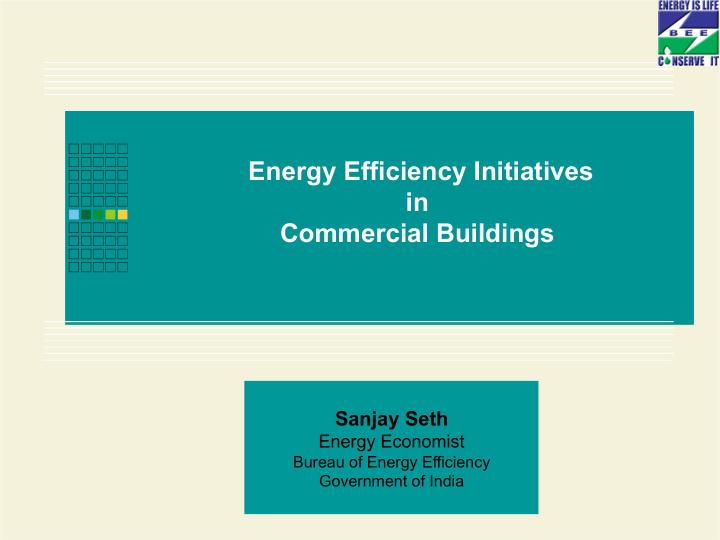



Energy Efficiency Initiatives in Commercial Buildings Sanjay Seth Energy Economist Bureau of Energy Efficiency Government of India Page 1 of 31
Overview of India ’ s Commercial Building Sector Sector Wise Electricity Consumption Traction Agricultu , 2% ral , 19% Others , 4% Industria l , 45% Resident ial , 22% Commer cial , 8% • The overall constructed area to increment by about 5 times from 21 billion square feet (2005) to approximately 104 billion square feet by 2030 at a CAGR between 5% to 10% . • Building energy consumption accounts for over 30 percent of electrical energy consumption in the country, and is rising annually at 8 % . • Lack of energy conscious designs lead to rampant inefficiencies in commercial buildings . Energy Audits show energy saving potential of up to 30-50% .Energy performance index (EPI) 200 to 300 kWh/sq m/year . Page 2 of 31
Growth in the Indian Building Sector Commercial Buildings Floor Area - Growth Forecast Ø Currently, ~ 659 million m 2 (USAID ECO-III Internal Estimate Using MOSPI, CEA and Benchmarked Energy Use data) Ø In 2030,~ 1,900 million m 2 (estimated)* Ø 66% building stock is yet to be constructed Current ¡ 659 ¡ 34% ¡ 1,900 million ¡ million m 2 m 2 ¡ Yet ¡to ¡be ¡ Built ¡ 66% ¡ Year: 2010 * Assuming 5-6% Annual Growth Year :2030 Page 3 of 31
Electricity Growth in Commercial Sector Page 4 of 31
Typical Building Energy Use • Lighting and Air Conditioning account for over 80% of energy end use in a typical commercial building in India while in residential building fan and lighting load are predominant . • Most of the existing lighting and air conditioning systems are not very efficient, leaving a wide scope for improvement in energy performance . • Overall the energy savings estimates for the commercial and residential buildings vary between 30-70%. • Challenge before India is to plan and implement energy efficiency measures during the early stages of growth in the building sector . Page 5 of 31
CLIMATIC ZONES OF INDIA Five climate zones:- 1. Composite (Delhi) 2. Hot Dry (Ahmedabad) 3. Hot Humid (Kolkata) 4. Moderate (Bangalore) 5. Cold (Shillong) Page 6 of 31
Page 7 of 31
Energy Conservation Building Code Ø ECBC covering the following components prepared: Ø Building Envelope (Walls, Roofs, Windows) Ø Lighting (Indoor and Outdoor) Ø Heating Ventilation and Air Conditioning (HVAC) System Ø Solar Hot Water Heating Ø Electrical Systems Ø ECBC finalized after extensive consultation Ø Voluntary introduction of ECBC in May 2007; mandatory after capacity building and implementation experience Ø Impact of ECBC - Reduced Energy Use for buildings Ø National Benchmark ~ 180 kWh/m 2 /year Ø ECBC Compliant building ~ 110 kWh/m 2 /year Page 8 of 31
Roadmap towards implementation Ø Development of ECBC training package covering the various aspects of the code Ø Development of ECBC User Guide Ø Conformance Check Tool developed Ø Implementation of ECBC Amendment of ECBC to suit local & regional climatic condition • Notification of ECBC in progress • Integration of ECBC in building bye-laws • Ø Modification in schedule of rates Ø Harmonization with NBC ( National Building Code) Page 9 of 31
Challenges to ECBC implementation Ø Adoption Ø State by state adoption after mandatory requirement Ø Implementation Ø Lack of expertise amongst architects, engineers and contractors Ø Lack of availability of equipment with prescribed efficiency levels Ø Lack of third party objective testing facilities that measure product efficiency with standard test procedures. Ø Enforcement Ø Enforcement at urban local bodies Ø Lack of expertise and human resources Ø Occupancy approval does not include all building systems Page 10 of 31
Projected growth in Floor Space & Energy Consumption- ‘ Business as Usual ’ scenario Year ¡ Floor space ( sq.m) ¡ Energy consumption (BU) ¡ 2005 ¡ 425 ¡ 36 ¡ 2012 ¡ 745 ¡ 166 ¡ 2017 ¡ 1114 ¡ 240 ¡ Source : “ Interim Report of the Expert Group on Low Carbon Strategies for inclusive Growth Page 11 of 31
Projected savings in new built up spaces Page 12 of 31
Cool Roofs – roadmap ahead Ø The Energy Conservation Building Code (ECBC) defines prescriptive requirements for cool roofs. Ø Promotion of Cool Roofs would include: Building parameters • Application options- materials and their energy performance • Implementation options- policy, promotional • Various technical and design considerations applicable. • Cool roofing, application, and maintenance issues. • Ø Providing details of cool roof technology and application, and access to the research carried out. Ø Analysis of the energy savings on account of application of cool roofs Page 13 of 31
www.bee-india.nic.in Page 14 of 31
Recommend
More recommend